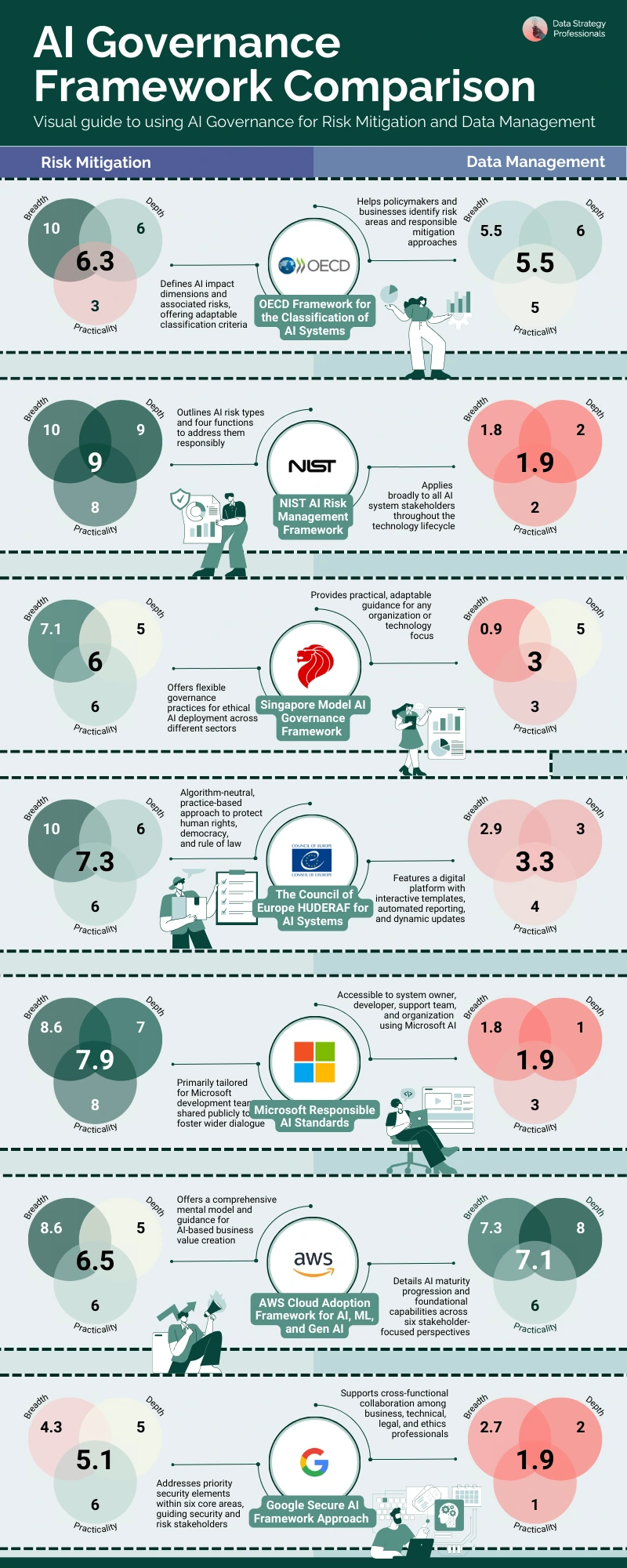Mac supports Data Strategy Professionals with newsletter writing, course development, and research into Data Management trends.
Introduction to AI Governance Frameworks
A brief introduction to seven leading AI Governance frameworks from public and private sector institutions, offering strategic insight on how to effectively deploy and operate AI systems. AI Governance Frameworks Comparison post 1 of 6.
Author: Mac Jordan | Post Date: Feb 7, 2025 | Last Update: Feb 19, 2025 | Related Posts
Artificial Intelligence is reshaping the business landscape. Alongside rapid adoption and technical advancements comes the pressing need for effective AI Governance. In this series, we explore best practices drawn from seven leading AI Governance frameworks, offering strategic insight on how to deploy and operate AI models. Incorporating survey data and advice from experienced data practitioners, we evaluate potential impact of leading AI Governance frameworks to improve data-driven decision-making.
The AI Governance Frameworks Comparison (AIGFC) series provides a thorough introduction to AI Governance frameworks to empower organizations of all sizes to deploy and operate AI with confidence. To provide context on the need for AI Governance frameworks, we outline adoption trends, risks associated with AI, and AI Governance practices.

Contents
Executive Summary
The AI Governance Frameworks Comparison (AIGFC) series aims to help data practitioners and C-level executives at businesses understand the need for AI Governance and the value potential of prominent AI Governance frameworks for deploying and operating AI.
"As business leaders survey the ecosystem of AI Governance, they find a confusing hodgepodge of guidelines and frameworks – a lot of mechanisms but not much clarity on how they fit together or which ones are likely to be useful."
– "A Guide to AI Governance for Business Leaders," Boston Consulting Group1
In order to understand the value of AI Governance, it is worthwhile to consider the following topics:
AI adoption: more businesses are using AI than ever before, yet many find successful adoption to be a challenge. We aggregate survey findings to understand the key barriers to adopting AI, especially over 2023-2024.
AI risks: evidence indicates a lack of awareness of the growing frequency and breadth of AI incidents and the need to practically mitigate various risks associated with AI.
AI Governance frameworks: we explore the use of AI Governance frameworks to address the most significant barriers to AI deployment and operation. Our overview covers the benefits, roles, responsibilities, and adoption trends associated with AI Governance.
Framework profiles: finally, we assessed seven leading AI Governance frameworks for their depth, breadth, and practicality across Risk Management and Data Management dimensions. We also identified common characteristics to help businesses implementing their own framework.
The report provides comprehensive analysis of seven leading AI Governance frameworks:
- Singapore's Model AI Governance Framework
- Microsoft Responsible AI Standard
- Alan Turing Institute's HUDERAF for AI Systems
- OECD's Framework for the Classification of AI Systems
- NIST AI Risk Management Framework
- Google Secure AI Framework Approach
- AWS Cloud Adoption Framework for AI, ML, and Gen AI
These frameworks offer suggested best practices on how to deploy and operate AI models effectively.
Our approach to exploring AI Governance frameworks:
- Highlight specific best practices and definitions
- Provide ratings that assess across breadth, depth, and practicality across Risk Management and Data Management dimensions
This series aims to provide useful guidance from leading frameworks and clarify the value potential for businesses to investigate each framework in more detail.
Background
AI Lifecycle Phases
The AI lifecycle is a series of phases that AI models go through from development to deployment and operation. The AI lifecycle phases are as follows: Design, Verify, Deploy, and Operate. AI Governance refers to a set of practices that help businesses manage AI models throughout the AI lifecycle. AI Governance practices are especially important for the deployment and operation phases of the AI lifecycle.2

The guidance provided by an AI Governance framework will become increasingly important as organizations develop and deploy more AI systems.
Types of AI Governance
According to Boston Consulting Group, types of AI Governance include AI principles, AI frameworks, laws and policies, voluntary guidelines, and standards and certifications. In particular, frameworks can help businesses manage AI models throughout the AI lifecycle, especially during the deployment and operation phases.1

Conclusion
In the AI Governance Frameworks Comparison (AIGFC) series, we assess the landscape of AI Governance frameworks from public and private sector institutions to provide guidance on their use. We evaluated the frameworks across two dimensions: Risk Management and Data Management. Our evaluation criteria included the following:
- Best practices and definitions
- Depth, breadth, and practicality
- Common characteristics
Our evaluation of the frameworks provides a comprehensive analysis of the value potential for businesses to investigate each framework in more detail. We aim to help data practitioners and C-level executives at organizations understand the need for AI Governance and the value potential of prominent AI Governance frameworks for deploying and operating AI.

Across the series, we analyze evidence for current AI adoption trends, AI risks, and AI Governance practices. We incorporate advice from experienced data practitioners and assess the value potential of leading AI Governance frameworks to mitigate risks and improve Data Management capabilities. Our aim is to provide a thorough introduction to AI Governance frameworks in order to empower organizations of all sizes to deploy and operate AI systems with more confidence.
Sign up for notifications about future posts in the series:
Endnotes
About Data Strategy Professionals
Our mission is to help test takers prepare for data-related certifications.
Since 2021, Data Strategy Professionals has offered training to data practitioners. We run several communities on social media, host a monthly discussion group on Zoom, and publish an email newsletter twice a month. Our study materials help data practitioners prepare for certifications related to Data Strategy, Data Analytics, Data Science, and Data Privacy.
Please don't hesitate to reach out to info@datastrategypros.com to share your goals. We look forward to assisting you on your Data Strategy journey.

Mac Jordan
Data Strategy Professionals Research Specialist











